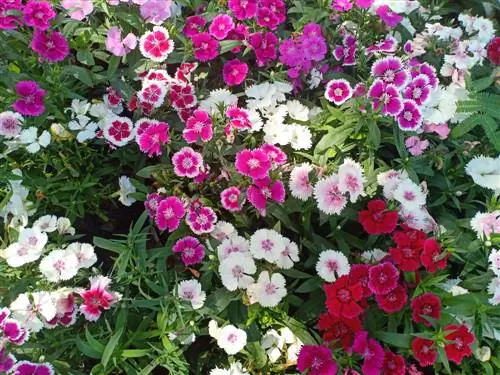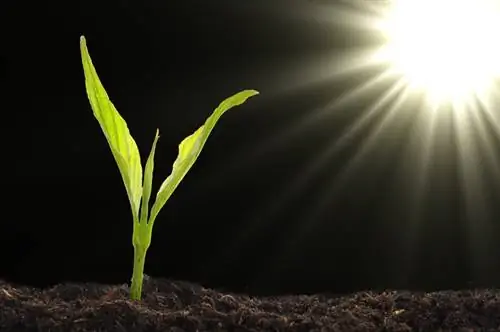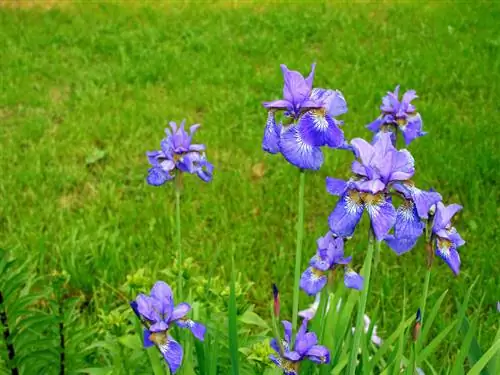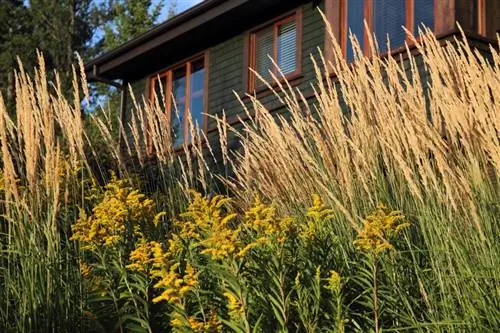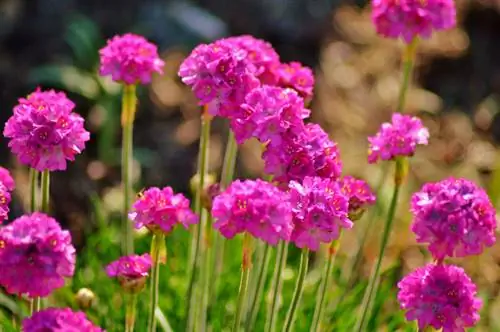- Author admin [email protected].
- Public 2023-12-25 17:45.
- Last modified 2025-01-23 11:21.
Carnations have impressed people for generations. Countless breedings have emerged from the wild species, each surpassing one another in color, shape and size. But for the culture to be successful, the specific location requirements must be taken into account. These differ depending on the variety.
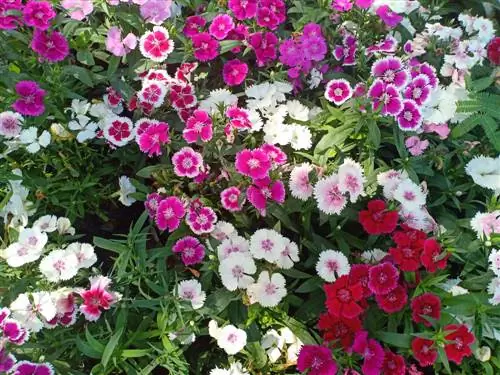
What are the characteristics and care requirements of carnations?
Carnations are ornamental plants from the carnation family and originally come from the Mediterranean region. They bloom in a variety of colors between June and September and prefer sunny, well-drained locations. They are propagated by seeds or cuttings.
Origin
Carnations are different varieties of a wild species that originally comes from the Mediterranean region. The plants belong to the carnation family and are sometimes referred to as sweet carnations. The wild species is known as the country carnation and has the scientific name Dianthus caryophyllus. The clove plant has been grown as an ornamental plant since ancient times. Carnations grow wild in Greece, Italy and on Sardinia and Sicily.
Growth
Land carnations grow as herbaceous plants that are perennial in their natural habitats. The plants grow to a height of between 40 and 80 centimeters and develop a spherical to bushy habit. As an ornamental plant, the carnation is usually cultivated as an annual.
leaves
The leaves of the sweet carnation are arranged oppositely. Its leaf blade has entire edges and is drawn out long. What is striking is the blue-green leaf color, which forms an aesthetic contrast to the flowers. The leaf shapes of the hybrid vary from the basic shape. Pot carnations often develop wider leaves that appear greener.
Bloom
Land carnations develop several flowers on a central shoot that branches out like panicles or appears simple. The crown consists of five intensely colored petals with a frayed edge. They are surrounded by four to six sepals. The carnation family develops hermaphrodite flowers that emit a light scent.
Flowering time
The flowering times of carnations differ depending on the variety. Carnations bloom between June and September in white, yellow, pink or intense red. Some varieties develop bicolor flowers that are often double and have a pleasant scent. The wild species Dianthus caryophyllus develops bright pink to purple petals.
Fruit
At the end of the flowering period, the flowers turn into capsule fruits that contain numerous seeds. When the fruit ripens, the capsule walls dry out and tear. When the stems are moved by the wind, the plant scatters its seeds.
Usage
Carnations transform beds and borders into a colorful sea of flowers. Their growth habit is best displayed in sunny places. The special requirements of these plants make them perfect companions for heather and rock gardens. They adorn terrace slopes and should not be missing in any cottage garden. Some varieties such as the almost forgotten mountain carnation are suitable for cultivation in pots or hanging baskets.
Is carnation poisonous?
Dianthus caryophyllus can be safely grown on the balcony, even if it is part of the cat's territory. Carnations are non-toxic to humans and animals. The plant parts were used in the past to flavor wine and beer or vinegar and syrup. The flowers are suitable for refining salads, desserts and sauces. They can be candied and used as decoration for cakes.
Which location is suitable?
Carnations love a location in full sun. They prove to be problem-free growers in hot and dry locations, although many hybrids rely on wetter conditions. Some varieties should be planted in a place protected from the wind as their shoots break easily. The wild species grows in natural habitats, including places exposed to wind.
What soil does the plant need?
The noble carnation finds perfect growth conditions on a very loose substrate. It requires high permeability. The stony and sandier the soil is, the better the carnation plant thrives. A slightly nutrient-rich substrate ensures optimal starting conditions. Cultivated forms require slightly more nutrients than the wild species. A few weeks before planting, mix some compost into the substrate to enrich the soil but not over-fertilize it. Flower formation is promoted by adding lime.
This is what carnations need:
- moderately fresh conditions
- even moisture
- rather low in nutrients
Propagate carnation
Land carnations can be propagated by sowing seeds, provided the varieties bear fruit. F1 series double hybrids do not develop seeds. Hanging cultivation forms are suitable for cutting cuttings.
Sowing
The seeds can be sown between mid-February and early March. The seeds germinate best on nutrient-poor potting soil with consistently moist conditions. At 15 to 18 degrees Celsius, seedlings appear after two to three weeks. When the first pair of leaves sprout, the young plants can be pricked out and further cultivated at 12 degrees Celsius. After the last late frosts, the carnation moves into the garden.
Cuttings
Hanging varieties can be propagated vegetatively via top cuttings or supporting shoots. While top cuttings are cut between September and November and overwintered in a nursery pot at five to six degrees, the period from January to March is suitable for cutting cutting shoots. In spring, both types of cuttings are grown in a room with temperatures between twelve and 14 degrees Celsius.
The correct planting distance
Place carnations in the bed taking into account the maximum growth width. The guideline is a distance of 20 centimeters between the plants. The carnation plants are planted so deep in the prepared planting hole that the base of the stem is flush with the surface of the soil. Press the substrate lightly so that the lowest leaves are not covered with soil. Water the carnations to close gaps in the ground.
Carnation in a pot
Self-grown young plants can be placed in a planter with a diameter of twelve centimeters. The prerequisite for pot culture is a well-drained substrate with good drainage. Hanging carnations are better suited for container planting. Make sure the soil moisture is even.
The ideal vessel:
- made of natural materials
- has vent holes
- is larger than the root ball
Balcony
Like the wild species, carnation hybrids also require an outdoor location. If you cultivate the plants in pots, you should give them a sunny spot on the balcony or terrace from spring onwards. The carnation plants need a lot of light. If you cultivate it indoors all year round, the shoots will quickly rot due to lack of light.
Water carnation
Carnations can be left to their own devices in the bed. In particularly long dry periods, you should use a watering can. Ten liters of water per square meter is enough to provide the plants with moisture. Hanging carnations need more water and prefer higher humidity. Mist the plants regularly and water more often once the top soil has dried.
Fertilize carnation properly
Land carnations are fertilized every four to six weeks during the vegetation phase if no compost was mixed into the substrate in spring. The fertilizer should be nitrogen-reduced (€47.00 on Amazon). Use an organic complete fertilizer in ball or stick form. This prevents the soil from being over-fertilized and the plant does not absorb excessive nutrients.
Cut carnations correctly
Remove spent shoots regularly and occasionally pinch off side flowers. This means the plant puts more energy into developing the main flowers. These flower shoots are suitable as cut flowers. No further cutting measures are necessary.read more
How do I transplant correctly?
Since carnations are often grown in beds as annuals, transplanting is not necessary. You can propagate the plant from seeds or cuttings if you want to enjoy the flowers again next year.
Wintering
As a plant in Mediterranean climate regions, the wild form of the carnation does not survive frosty temperatures. Overwintering in a bucket is possible. However, transplanting from the field into the pot means stress for the carnations. Therefore, you should cut top cuttings in autumn and overwinter them. During overwintering, excessive moisture in the substrate is the biggest problem. Therefore, make sure you water sparingly.read more
Fungal infestation
Various fungi can spread on the carnation plants if the location conditions are incorrect. Proper care prevents infestation.
Carnation Blackness
This disease is manifested by initially light and later brownish spots on the leaves. They are outlined in red and occasionally appear on buds and shoots. Black fungal spores form in the center of the spots.
Accidental Sickness
If seeds are sown too densely, the seedlings compete for light and develop unstable stems. The same applies to seeds grown in very warm conditions and little light. The base of the stem often appears cut and bends easily. It turns black because various fungal spores settle at the bends.
Pests
There are a number of pests that prefer to settle on carnation cultivars. They should be combated promptly so that the plant is not damaged too much.
Thrips
Silvery white or nut brown spots on the fresh leaves indicate a thrips infestation. The leaves wither because the sucking insects negatively affect growth.
Aphids
Aphids occasionally appear on young shoots and leaves if the air is too dry. They leave behind a sticky substance on which rust fungi settle.
Carnation flies
The larvae of these pests eat through the leaf tissue of fresh leaves and leave behind microscopic tunnels. The foliage yellows and slowly dies.
Spider mites
These red insects settle on the undersides of leaves and leave behind a fine web that becomes visible when sprayed with a fine mist of water. A severe infestation causes the leaves to become stained and later yellow.
Tip
Some carnations are suitable as cut flowers. To ensure a regular and straight growth habit, you should stick a stick into the ground when planting and attach the stem to it.
Varieties
- Grenadin: Perennial carnation plant, is propagated from seeds. Flowers white, pink and red with a pleasant scent of cloves. Forms stable stems up to 40 centimeters high.
- Ikat: Frost-proof and robust. Flowers speckled pink, blooms from June to September. Up to 50 centimeters high.
- Chabaud: Biennial perennial. Colorful flowers from July to October. Up to 60 centimeters high.

